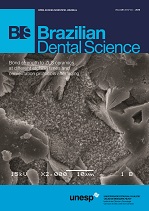Endodontic treatment of a large periapical cyst with the aid of antimicrobial photodynamic therapy - Case report
DOI:
https://doi.org/10.14295/bds.2019.v22i4.1745Abstract
Introduction: Periapical cysts, especially those of great extension, represent a challenge for endodontics, since they are not repaired with traditional treatment. The aim of this case report was to evaluate the effectivity of antimicrobial photodynamic therapy “aPDT” when associated with calcium hydroxide Ca(OH)2 in treating such cysts. Case report: A 40-year-old female patient complained of bulging in the upper anterior region of the mouth. The clinical examination showed an extensive swollen periodontal area, painful with digital palpation, with a negative response to thermal tests on teeth 11 and 21. After traditional treatment, the canals of 11 and 21 were filled with photosensitizer methylene blue 0.005% pre irradiation time (PIT) of 5 minutes and irradiation by low power diode laser with visible red wavelength (660 nm) during 2 minutes without intervals, using an optical fiber delivering system with a helical movement from apical to cervical. Then the canal were filled with Ca(OH)2 paste for 45 days being changed each 15 days, and repeating the radiation. Results: After 45 days, the patient already had a bulging remission, with painless resistance to apical pressure in the region and signs of bone repair at the radiographic examination, and total absence of signs or symptoms. Conclusion: the association of aPDT with Ca(OH)2 paste is effective in treating of periapical lesions of great extension and avoid surgical treatment.
Keywords: Antimicrobial; Calcium hydroxide; Diode Laser; Periapical cysts; Photodynamic Therapy; Root canal treatment.
Downloads
Downloads
Additional Files
Published
How to Cite
Issue
Section
License
Brazilian Dental Science uses the Creative Commons (CC-BY 4.0) license, thus preserving the integrity of articles in an open access environment. The journal allows the author to retain publishing rights without restrictions.
=================




























